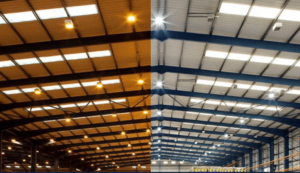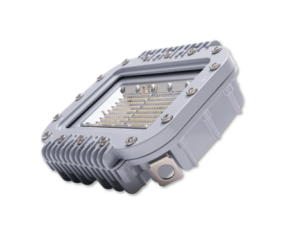From the PPE your team wears to the lubricant that keeps your machines humming, there’s not a detail of your industrial operation that doesn’t account for the safety and wellbeing of your team. But depending on the type of lighting in your facility, you may be creating a less safe workspace than you think. LED lighting is quickly becoming the go-to lighting solution for industrial facilities for a whole host of reasons. Chief among them is safety.
As completely solid-state devices, LEDs have no air, glass, or fragile filaments. That makes them extremely resistant to damage from shock and vibration. When it comes to energy efficiency, the lumens per watt of LED lighting fixtures is much higher than other conventional lighting options.
High Pressure Sodium Lighting vs. LED

But high-pressure sodium fixtures also gives off an unnatural orange glow, and delivers poor color rendering. In the event of power loss, they have a long restrike time – up to 20 minutes in some cases.
LED, on the other hand, delivers both superior efficiency and performance. In fact, when designed properly, LED systems offer superior energy efficiency, reliability, longevity, improved light levels, visual clarity, and long-term cost savings. They turn on instantly, last up to three times longer than high pressure sodium lights and contain no mercury.
Visibility is Paramount to Improved Safety
More than $250 billion is estimated to be spent each year on jobsite injuries.1 Poor lighting has been identified by the U.S. Department of Labor to be a leading cause of injuries resulting from slip, trip, fall, and contact with objects and equipment in industrial workplaces.2 Industrial environments are harsh and require high quality lighting that is efficient, supports productivity, and most importantly ensures the safety of employees. In fact, clear visibility of hazards has been found to reduce accidents causing injuries or death in the workplace by up to 60%.3
Industrial Lighting Design for Harsh Settings
Each industrial facility is different and can provides its own unique blend of conditions that can affect safety, including:
Airborne contaminants like dust, chemical vapors, and volatile organic compounds
- Windblown dirt and salt spray
- Extreme temperatures
- Humidity, moisture, and condensation
- Corrosion
- Shock and vibration
- Power surges
- Flammable, explosive, and combustible atmospheres
In settings like these, light-duty, commercial grade, off-the-shelf lighting won’t cut it. These fixtures are simply not built to hold up to the various conditions present in an industrial facility. Industrial fixtures need to be tested and proven in extreme environments to ensure they can hold up to anything and won’t fail when your team needs them most.
Creating a Safer Workplace through Industrial Lighting Design

Your journey toward a brighter and safer industrial facility begins with Agilix Solutions. Contact your account manager today or reach out to your nearest branch to start the conversation.
1. Leigh J.P., “Economic Burden of Occupational Injury and Illness in the United States”. 2. U.S. Dept. of Labor, Census of Fatal Occupational Injuries Summary, 2016; Occupational Health and Safety Administration, Mine Safety and Health Administration. 3. Abdou, “Effects of Luminous Environment on Worker Productivity in Building Spaces”
